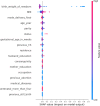Application of machine learning in identifying risk factors for low APGAR scores
- PMID: 40340577
- PMCID: PMC12060381
- DOI: 10.1186/s12884-025-07677-y
Application of machine learning in identifying risk factors for low APGAR scores
Abstract
Background: Identifying the risk factors for low APGAR scores at birth is critical for improving neonatal outcomes and guiding clinical interventions.
Methods: This study aimed to develop a machine-learning model that predicts low APGAR scores by incorporating maternal, fetal, and perinatal factors in Wad Medani, Sudan. Using a Random Forest Classifier, we performed hyper-parameter optimization through Grid Search cross-validation (CV) to identify the best-performing model configuration.
Results: The optimized model achieved excellent predictive performance, as evidenced by high F1 scores, accuracy, and balanced precision-recall metrics on the test set. In addition to prediction, feature importance analysis was conducted to identify the most influential risk factors contributing to low APGAR scores. Key predictors included gestational age, maternal BMI, mode of delivery, and history of previous complications such as stillbirth or abortion. Using 5-fold cross-validation (CV), the random forest model performance scored accuracy at 96%, precision at 98%, recall at 97%, and F1-score at 97% when classifying infants with APGAR score.
Conclusion: This study underscores the importance of incorporating machine learning approaches in obstetric care to understand better and mitigate the risk factors associated with adverse neonatal outcomes, particularly low APGAR scores. The results provide a foundation for developing targeted interventions and improving prenatal care practices.
Keywords: Artificial intelligence; Low APGAR score; Machine learning; Risk factors.
© 2025. The Author(s).
Conflict of interest statement
Declarations. Ethics approval and consent to participate: The study received ethical approval from the Research Board of the Faculty of Medicine, University of Gezira, Sudan (reference number 2023, #6). Written informed consent was obtained from all enrolled women in accordance with the Human Rights Declaration of Helsinki. Consent for publication: Not applicable. Competing interests: The authors declare no competing interests.
Figures






Similar articles
-
Prediction of low Apgar score at five minutes following labor induction intervention in vaginal deliveries: machine learning approach for imbalanced data at a tertiary hospital in North Tanzania.BMC Pregnancy Childbirth. 2022 Apr 1;22(1):275. doi: 10.1186/s12884-022-04534-0. BMC Pregnancy Childbirth. 2022. PMID: 35365129 Free PMC article.
-
Identifying determinants of malnutrition in under-five children in Bangladesh: insights from the BDHS-2022 cross-sectional study.Sci Rep. 2025 Apr 24;15(1):14336. doi: 10.1038/s41598-025-99288-y. Sci Rep. 2025. PMID: 40274916 Free PMC article.
-
Perinatal risk factors and Apgar score ≤ 3 in first minute of life in a referral tertiary obstetric and neonatal hospital.J Obstet Gynaecol. 2020 Aug;40(6):820-824. doi: 10.1080/01443615.2019.1673708. Epub 2020 Feb 26. J Obstet Gynaecol. 2020. PMID: 32098552
-
Pre- and Perinatal Characteristics Associated with Apgar Scores in a Review and in a New Study of Dutch Twins.Twin Res Hum Genet. 2019 Jun;22(3):164-176. doi: 10.1017/thg.2019.24. Epub 2019 Jun 14. Twin Res Hum Genet. 2019. PMID: 31198125 Review.
-
The intrapartum and perinatal risks of sleep-disordered breathing in pregnancy: a systematic review and metaanalysis.Am J Obstet Gynecol. 2018 Aug;219(2):147-161.e1. doi: 10.1016/j.ajog.2018.02.004. Epub 2018 Feb 15. Am J Obstet Gynecol. 2018. PMID: 29454869
References
-
- American Academy of Pediatrics Committee on Fetus, Newborn and American College of Obstetricians, Gynecologists Committee on Obstetric Practice, Watterberg KL, Aucott S, et al. The apgar score. Pediatrics. 2015;136(4):819–22.
-
- Gr R, Lidegaard Ø, Pedersen LH, Andersen PK, Kessing LV, et al. Maternal depression, antidepressant use in pregnancy and Apgar scores in infants. Br J Psychiatr. 2013;202(5):347–51. - PubMed
-
-
Bouzada MCF, Nogueira Reis ZS, Brum NFF, Penido Machado MG, Rego MAS, Anchieta LM, et al. Perinatal risk factors and Apgar score
 3 in first minute of life in a referral tertiary obstetric and neonatal hospital. J Obstet Gynaecol. 2020;40(6):820–4.
-
PubMed
3 in first minute of life in a referral tertiary obstetric and neonatal hospital. J Obstet Gynaecol. 2020;40(6):820–4.
-
PubMed
-
Bouzada MCF, Nogueira Reis ZS, Brum NFF, Penido Machado MG, Rego MAS, Anchieta LM, et al. Perinatal risk factors and Apgar score
MeSH terms
Grants and funding
LinkOut - more resources
Full Text Sources

